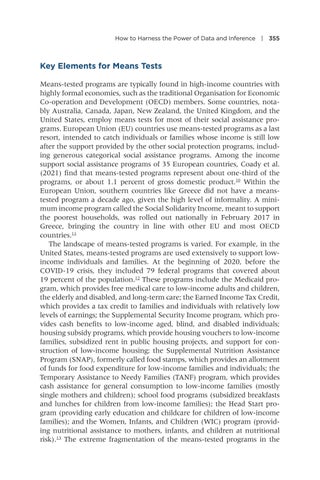How to Harness the Power of Data and Inference | 355
Key Elements for Means Tests Means-tested programs are typically found in high-income countries with highly formal economies, such as the traditional Organisation for Economic Co-operation and Development (OECD) members. Some countries, notably Australia, Canada, Japan, New Zealand, the United Kingdom, and the United States, employ means tests for most of their social assistance programs. European Union (EU) countries use means-tested programs as a last resort, intended to catch individuals or families whose income is still low after the support provided by the other social protection programs, including generous categorical social assistance programs. Among the income support social assistance programs of 35 European countries, Coady et al. (2021) find that means-tested programs represent about one-third of the programs, or about 1.1 percent of gross domestic product.10 Within the European Union, southern countries like Greece did not have a meanstested program a decade ago, given the high level of informality. A minimum income program called the Social Solidarity Income, meant to support the poorest households, was rolled out nationally in February 2017 in Greece, bringing the country in line with other EU and most OECD countries.11 The landscape of means-tested programs is varied. For example, in the United States, means-tested programs are used extensively to support lowincome individuals and families. At the beginning of 2020, before the COVID-19 crisis, they included 79 federal programs that covered about 19 percent of the population.12 These programs include the Medicaid program, which provides free medical care to low-income adults and children, the elderly and disabled, and long-term care; the Earned Income Tax Credit, which provides a tax credit to families and individuals with relatively low levels of earnings; the Supplemental Security Income program, which provides cash benefits to low-income aged, blind, and disabled individuals; housing subsidy programs, which provide housing vouchers to low-income families, subsidized rent in public housing projects, and support for construction of low-income housing; the Supplemental Nutrition Assistance Program (SNAP), formerly called food stamps, which provides an allotment of funds for food expenditure for low-income families and individuals; the Temporary Assistance to Needy Families (TANF) program, which provides cash assistance for general consumption to low-income families (mostly single mothers and children); school food programs (subsidized breakfasts and lunches for children from low-income families); the Head Start program (providing early education and childcare for children of low-income families); and the Women, Infants, and Children (WIC) program (providing nutritional assistance to mothers, infants, and children at nutritional risk).13 The extreme fragmentation of the means-tested programs in the


